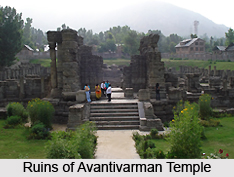 Avantivarman group of temples are rather magnificent structures built in the latter half of the 9th century. King Avantivarman, who ascended the throne of Kashmir during this time, ushered in a most memorable era in the history of architecture in Kashmir. He built a group of temples at Avantipur, a township situated about 18 miles away from Srinagar. Of this group of temples, the Avantiswami temple, which is dedicated to Lord Vishnu, still survives in part. It has been said that whereas the Martand temple is the expression of a "sudden glory", the Avantiswami temple shows greater maturity of experience and has therefore more sophistication and elegance.
Avantivarman group of temples are rather magnificent structures built in the latter half of the 9th century. King Avantivarman, who ascended the throne of Kashmir during this time, ushered in a most memorable era in the history of architecture in Kashmir. He built a group of temples at Avantipur, a township situated about 18 miles away from Srinagar. Of this group of temples, the Avantiswami temple, which is dedicated to Lord Vishnu, still survives in part. It has been said that whereas the Martand temple is the expression of a "sudden glory", the Avantiswami temple shows greater maturity of experience and has therefore more sophistication and elegance.
The temple has graceful colonnades of pillars which form an arcaded portico around the shrine. There is a monolithic pillar before the entrance which bears a metal figure of Garuda, the emblem of Lord Vishnu. There a number of motifs those have been borrowed from various sources, both foreign and indigenous, which appear in the decorative carving. It is of particular note that they have been rather tastefully integrated into an ordered system with a recognizable unity. Designs reminiscent of the Buddhist stone carvers of the Ashokan age and of the craftsmen of the Pala school are frequent and symbols traceable to Byzantium, ancient Persia and Syria are also found. The conspicuously angular aspect of this temple is derived from the wooden houses of the valley where the accumulation of heavy snow on the roofs is prevented by their sloping character.
This article is a stub. You can enrich by adding more information to it. Send your Write Up to content@indianetzone.com





















